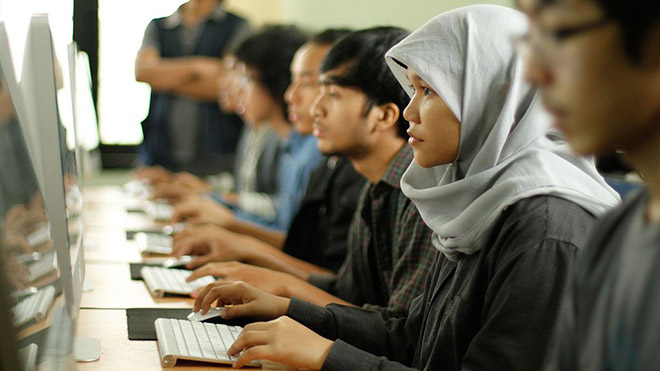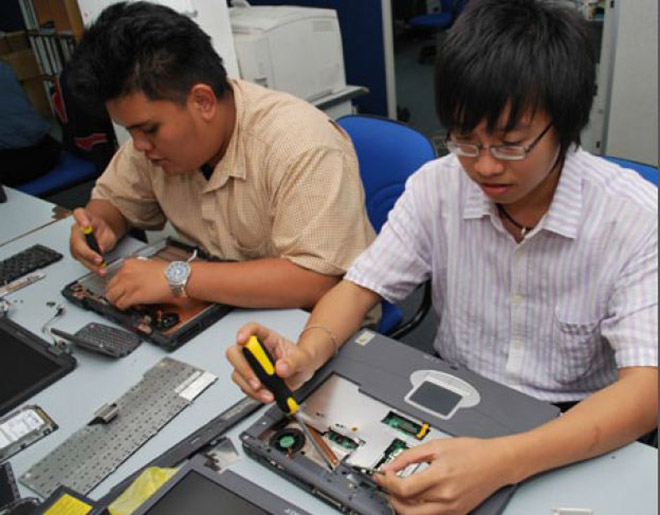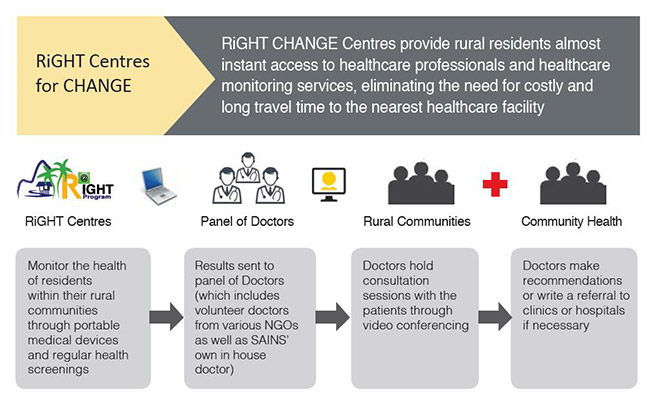 “BUSINESSES cannot be successful when the society around them fails,” said a speaker during the Responsible Business Summit held in London.
“BUSINESSES cannot be successful when the society around them fails,” said a speaker during the Responsible Business Summit held in London.
For many businesses today, corporate social responsibility (CSR) plays a more pivotal role in a corporate growth story as it is now more than just making money and satisfying customers.
Fresh from its 25th anniversary celebration last year, information and communication technology (ICT) solutions provider, Sarawak Information Systems Sdn Bhd (SAINS), has recorded exponential growth since its inception with products and solutions found in various governments bodies and private organisations in Malaysia and abroad.
Best known for its world-class ICT business solutions, SAINS has garnered numerous domestic as well as international awards for its wide range of innovative and cost effective ICT solutions.
On the global platform, SAINS was voted as one of the ‘25 Most Promising GIS Solution Providers in Asia Pacific’ by Asia Pacific CIO Outlook Magazine 2016.
While SAINS continues its ascend in the ICT sector and its expansion across the globe, the organisation stayed firm to its core value of giving back to the community.
SAINS’ Rural ICT Guided Home-based Technopreneur (RiGHT) programme and its supplementary RiGHT Community Healthcare Advancement Nurturing for Growth Ecosystem (CHANGE) programme embody that value as these programmes are aimed to uplift the rural community by bridging the digital divide between urban and rural areas in Sarawak.
“My passion that I want to incorporate into SAINS’ core, is to give back to the community and share what we are doing with the community.
“In my previous experience as a civil servant, I had witnessed the socio-economic condition of the people the rural areas. As soon as we are able to ensure that SAINS can go at a steady pace, my goal is for us to share what we have done to the community,” SAINS chief executive officer Dato Teo Tien Hiong shared with BizHive Weekly recently.
He added, “My passion is also to bring socio-economic development and modernity to rural areas, so we can uplift the underprivileged communities in the rural areas. That is also the underlying philosophy behind RiGHT and RiGHT CHANGE.”
In line with the late Datuk Patinggi Tan Sri Adenan Satem, fifth Chief Minister of Sarawak, SAINS’ CSR programmes revolves around the usage of technology to modernise the rural community.
“I have a concern and deep commitment to bridge the digital bridge between urban and rural areas and bring modernity to rural areas,” he said, last year in a speech read by Deputy Chief Minister Datuk Amar Douglas Uggah Embas during SAINS’ 25th Anniversary Dinner.
He added, “I have instituted a policy to go rural and set key performance indicators (KPIs) for the state elected representatives to gauge their involvements with their respective constituents.
“And I can immediately see the relevancy of many current SAINS CSR programmes which can be adapted for this purpose.”
And with that, SAINS can be seen as making an effort in realising the late Adenan’s dream.
Teo said, “We want to see how we can leverage on technology and our skills in ICT, to produce a sustained, broad-based programme that will benefit the rural communities by way of socio-economic development, bridging the digital divide and bringing modernity to the rural areas.”
BizHive Weekly explores SAINS’ CSR efforts in Sarawak.
Heading the RiGHT way: SAINS grooms technopreneurs for brighter future

At the core of SAINS’ longest running CSR programme; the Rural ICT Guided Home-based Technopreneur (RiGHT) programme, is the aim to bridge the urban-rural digital divide in rural areas on a sustainable basis through ICT capacity building in youths.
As the saying goes, youths are the leaders of the future.
By offering them an opportunity to improve their lives through using technology, the RiGHT programme encourages youths to play a more meaningful role in the socio-economic development of their rural communities.
Its objective is also to create a generation rural youths that are ICT literate and groomed to provide ICT support within the rural communities.
“We want to see how we can leverage on technology and our skills in ICT, to produce a sustained, broad-based programme that will benefit the rural communities by way of socio-economic development, bridging the digital divide and bringing modernity to the rural areas,” said Dato Teo Tien Hiong, SAINS’ chief executive officer.
Under the RiGHT programme, selected youths/candidates undergo a six-month intensive training course in ICT-related fields as well as a practical attachment to various units in SAINS. Candidates are also provided with entrepreneurship training.
After graduation, these youths are then encouraged to set up RiGHT ICT Service Centres at their rural communities to provide services such as training, repairs, and e-commerce services to promote rural cottage industries and eco-tourism from their communities. This is expected to enhance the monetisation of Sarawak’s rural human and natural resources.
“Following the programme, if the alumni still express interest or determination, we will continue to guide them or help them in things such as setting up an ICT centre,” said Teo.
“We hope to see our candidates living sustainable successful lives. If our candidates decided to return to his/her rural village, we want to support them there to ensure that they could sustain their livelihood with the skills they’ve gained,” he added.
Now in its 12th year since its initiation in 2005, the RiGHT programme has seen over a hundred participants.
“From what I have seen, some have found jobs, some went on to continue their studies, some have returned to their rural community to set up ICT centres there and we will assist them with that,” Teo added.
The ripple effect of the programme can be seen as wide and far reaching as the RiGHT programme could benefit a multitude of parties.
Rural youths that have participated in the programme directly benefit from it in terms of being equipped with valuable and marketable skills.
It also offers them employment opportunities as well as a foundation to improve their lives.
The skills that SAINS have imparted on the participants can also be used to improve the livelihood of the community as participants could act as the local ICT experts in their own communities.
The establishment of RiGHT-supported ICT centres in the community also brings modernity to rural communities as well as the opportunity to improve rural living conditions.
On a wider scale, according to SAINS, the programme has the potential of creating a layer of RiGHT participants throughout the state, who could not only make a difference in bridging the urban-rural digital divide, but also be active players in the economic development of the state.
“On a larger scale, the programme could be an important contributor to the ultimate national vision of knowledge economy and knowledge society,” it said.
Being the RiGHT CHANGE: SAINS brings healthcare solutions to rural areas

Establishing and sustaining medical or healthcare services in rural areas have always been one of many challenges faced by governments worldwide.
Similarly, in Sarawak, rural healthcare has been one of many focal points debated by many when it comes to rural development.
While Sarawak’s government has made tremendous successes in expanding the rural healthcare here, due to its vast geography and challenging topography, the state still faces many barriers such as infrastructural, financial, and other limitations.
As a possible way to support the rural healthcare sector, SAINS has taken a step forward by using its expertise in ICT to reach out and provide medical assistance to rural dwellers.
Based on the concept of telemedicine, SAINS’ Rural ICT Guided Home-Based Technopreneur Community Healthcare Advancement Nurturing for Growth Ecosystem (RiGHT CHANGE) programme aims to promote rural healthcare through the implementation of innovative and sustainable integrated healthcare solution for the rural community.
Officially launched in 2015, by the State Secretary of Sarawak, Tan Sri Datuk Amar Mohamad Morshidi Abdul Ghani, the RiGHT CHANGE programme is now entering its second year and while it is still at its pilot stage, SAINS believes that the programme is now showing significant progress and potential since its inception.
“Undoubtedly, health is the most important matter for an individual. For almost 20 years, we have been talking about telemedicine but until today, development hasn’t been significant. But, SAINS has achieved that through this RiGHT CHANGE programme.
“My vision is to enhance/uplift the rural living condition. If the community is healthy, they can support and even boost the village’s socio economic development,” Teo pointed out to BizHive Weekly.
For SAINS’ RiGHT CHANGE programme, prevention is key to a healthy community. In this case, the programme identifies the problem before it occurs by screening, collecting and storing health data and statistics of the rural community.
As an extension of the RiGHT programme, RiGHT CHANGE leverages on the already established RiGHT centres set up by RiGHT graduates in rural areas.
The RiGHT CHANGE also makes use of the facilities at the centres such as the IT equipment, teleconferencing facilities, the Sarawak Government wide area network; the SarawakNet, as well as SAINS’ in-house developed Integrated Healthcare Solution and portable medical testing equipment or participant medical kit (PMK).
The way the programme works is via the help of RiGHT alumni as well as ‘Wakil Kesihatan Kampung’ or rural health volunteers (WKK), and SAINS’ well-established network and database. At the service centres established by RiGHT alumni, RiGHT alumni will make use of the PMK. The kit consists of various essential and medical devices such as rural healthcare solutions (Participant Medical Record Systems and Rural Healthcare Monitoring Systems), blood pressure measuring device, blood sugar measuring devices and more.
SAINS’ RiGHT alumni will monitor the health of participants within their communities through the use of these portable medical devices and through regular health screening. The information are then gathered and uploaded to SAINS’ database which can trigger alerts to a panel of volunteer doctors as well as SAINS’ in-house panel doctor.
The setup also allows doctors to hold videoconferencing consultations with the patients, if necessary and in the event where the respective patient shows a need to be treated, the doctor can provide referral advice as generated by Rural Healthcare Applications.
Delving further into the programme, BizHive Weekly talks to one of SAINS’ panel doctors attached to the programme on his first hand account of the RiGHT CHANGE’s progress.
SAINS’ Public Health Medicine physician and panel medical doctor, Dr Junaidi Diki, initially came onboard the programme because he felt like there is still more that could be done for rural healthcare especially here in Sarawak, where there are many areas that are hard to reach and countless rural folks in need of healthcare services.
In his report for SAINS JENDELA iT, Junaidi noted that the health status of the rural community, particularly, in respect to the prevelence of chronic diseases, is not well documented.
“There are a lot of challenges when it comes to rural healthcare. There is a lack of infrastructure, finances, access as well as experts with the skills and knowledge to treat the patients there.
“To overcome these limitations, SAINS has brought its solutions into place,” Junaidi said.
He believed that SAINS, through RiGHT CHANGE, is trying to address this issue and has provided a solution for doctors like him to reach out to the rural folks by making healthcare monitoring and medical consultations available, virtually.
“I believe that this RiGHT CHANGE programme is beneficial for rural folks as it aims to prevent ailments by identifying the signs of it before it worsens.
“With data collected by our RiGHT candidates through this programme, we will be able to identify the problem before it happens and I, as a doctor, will be able to give the right medical advices for the patients there,” he added.
In his report, he also pointed out that the initial data collected are alarming and requires immediate attention.
“It is a challenging feat to narrow the gap and improve community health with the handicap of scarce resources, various limiting factors, and the escalating healthcare cost worldwide.
“This activity (RiGHT CHANGE) enables us to explore community health morbidity, estimate the prevalence and incidences of chronic diseases, monitor and assess existing medical care, provide health information and education, impart health promotion messages and conveniently provide medical consultation and referrals to the rural community via their local RiGHT Alumni,” Junaidi said in his report.
He noted that RiGHT alumni do not need a medical background when it comes to RiGHT CHANGE programme as the candidates will be taught on how to operate the devices as well as how to record data from the equipment provided.
Roneo Joseph Bunchol, an information system executive at SAINS as well as manager in charge of SAINS’ CSR programme, pointed out: “The villagers also do not have to travel so far to reach the town area.
“With this system, they can do the testing at the ICT centre and the results will be uploaded into the system and it will be analysed by the panel doctor.”
Besides that, another benefit of the programme is the minimal cost it takes to set up and maintain the centre and the programme.
Currently, he noted, that out of 18 RiGHT ICT centres, there are currently six pilot sites for SAINS’ RiGHT CHANGE programme. These sites include Kampung Tambirat Tengah (Asajaya), Kampung Menek (Sebangan, Simunjan), REDEEMS Centre (Singai, Bau), Kampung Baru (Balingian, Mukah), Kampung Bungey (Debak, Betong), and Kampung Tengah (Maludam).
The sky’s the limit: SAINS aims to reach another milestone
Looking ahead, it is estimated that RiGHT CHANGE would be able to benefit over one million people in rural Sarawak. According to SAINS, the programme could help the government save millions of ringgit each year by catching potential sufferers of chronic diseases.
It also pointed out that the largest and fastest growing cost of healthcare is the treatment of chronic diseases such as diabetes and hypertension of which, Dr Junaidi pointed out, recorded a surprisingly large number in the rural areas based on data collected through RiGHT CHANGE.
Nevertheless, while RiGHT CHANGE’s main objective is to detect and prevent illness before it occurs, SAINS has expressed interest in helping the healthcare sector by providing a treatment solution.
Teo revealed, “While RiGHT CHANGE’s main objective is to detect illness before it occurs, we also hope that the programme could help through treating those who are ill.
“Moving forward, we want to look into how we can help them. We want to use our technology not only to prevent by monitoring, we also want to see if we could explore the curative side of healthcare.”
With that, he told BizHive Weekly that currently, SAINS is looking into the usage of unmanned aerial vehicles (UAVs), or more commonly known as drones, to support its CSR project.
“We are now exploring the usage of drones to deliver medications/healthcare supplies to the villages. Our plan is to have a person on the ground, he/she would have a home-based technology and all he/she has to do is to give their coordinates, then from a nearby base where we could get these supplies, we could supplies with drones.
“That way, in what should take days or half a day through our rough terrains, could just take just minutes. These drones could drop the supplies to the RiGHT person or the right receiving person.
“Our panel doctors here could communicate with the patients virtually, subsequently, they could attach the medications or supplies to our drones and it will be delivered to our RiGHT candidates at the rural village and this candidate will give the medications to the patient there.
“This could happen, I believe,” Teo commented.
Of note, SAINS is no stranger to the development and research of drones. During SAINS’ 25th Anniversary Dinner held last year, Teo had highlighted that SAINS is looking into eight key areas to see how the agency could be leveraged further.
“Geomatics involving gathering, storing, processing, and delivering geographic information from satellite imagery to remote sensing imagery like drones. Logistic because it is the driver of the economy.
“We cannot leave out healthcare and education as well as energy, power and utility which are of particular interest to Sarawak which has so much energy potential, as well as the local government, information, cyber security and spatial surveillance,” he said in his speech that night.
It is also worth noting that delivery by drones may not be a far-fetched idea as many developed countries such as US, New Zealand, and Japan as well as major global conglomerates such as Amazon, Google, and 7-Eleven Inc are already making major developments into realising the possibility of mass drone delivery.
“For us, it could be easier as we’re only delivering the supplies to the RiGHT candidates that need it. It’ll be fast, it’ll be affordable, and it will be achievable.
“This is what we’re planning for it. It will take a bit of time to implement this, but it’s something that I want to move onto, next,” Teo said.
Meanwhile, SAINS has also expressed its interest in partnering with more agencies and government departments in organising its CSR programmes.
“This is something very exciting for us. And all this, we’d like to do to benefit the community. It is not solely for us, but for the community as well,” Teo concluded.
